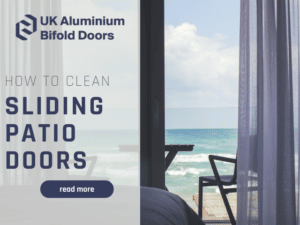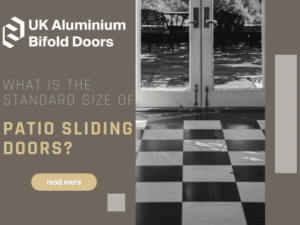You really can’t go wrong with a set of aluminium bifold doors. These doors offer an easily-accessible link between the outdoors and your home’s interior, providing a near-panoramic view through their stylish panels.
Not only do they bring an added touch of class to already exclusive properties, but they’re also durable and will add substantial value to your home. With such high-quality doors, you must know how to look after them to benefit appropriately from their total value. This article will look at adjusting your aluminium bifold doors.
Identifying an Aluminium Bifold Door Fault
Whenever you identify any problem, your initial objective should be to zone in on where the pain originates. When it comes to bifold doors, you’ve probably recognised the problem with your doors not closing or perhaps locking as they should.
If this is indeed the case, the first place you should look to find the problem’s origin is whether your doors might have become misaligned with their tracking and may need adjustment. If this isn’t where the problem lies, investigate whether your doors may have dropped and require lifting.
What adjustments you should make depends on with which mechanism your doors operate. If your bifold doors are on bottom rollers, you’ll need to check for the correct alignment on the track. You should check doors suspended from overhead tracks to ensure they’re hanging as they should.
Whatever you find, as long as you have an adjustable make of bifold doors, you can take steps to realign your aluminium bifold doors. Fortunately, with the aluminium doors we offer at UK Aluminium Bifold Doors, there are ways of adjusting them, so we’ll explain how in greater detail now.
How To Adjust Aluminium Bifold Doors
Start the process by sliding your bifold doors open and closed to identify precisely where your doors’ problem lies.
Lead bifold door
You should begin with the lead door, which you move to pull all the other interconnected doors and pull it into the locking position against the jamb. Check whether it binds properly into the door frame and rests correctly in the opening.
If the lead door isn’t sliding as it should or resting in the correct position, the other doors will also appear to stick and not open properly. In this case, you may need to make horizontal adjustments to the lead door.
Horizontal adjustment
Using a common Allen key, you can adjust the lead door to the left or right. Locate the hinges on the sill and use the Allen key to adjust them randomly until your door is moving smoothly and closing properly.
Dragging or loose-tracked doors
If you find that your bifold doors are misaligned on the hinges or are disconnecting from their tracks when you try opening them, there’s likely a problem with the doors’ height. In cases like this, you’ll need to focus on the hinge bolts.
Hinge bolt adjustment
You can adjust the height of your bifold doors by extending or pushing the hinge bolts on the doors themselves. Extending the bolt will raise the door while pushing it will lower it. Experiment until such a time as you find the position where the doors function properly. The precise setting will vary between doors, so this process has no set formula.
It’s most definitely worth trying some minor adjustments yourself, as you’ll likely be able to rectify the problem. It might be worth seeking professional assistance to solve the problem if you do not find a solution by making adjustments to the hinges. Try a little home maintenance yourself first, though.
If you get your hinges fixed into the correct position, you’ll find that your bifold doors will be fitted properly again, and the adjusted doors will push easily closed or open and sit as they should.
Removing Bifold Doors for Alteration or Repair
The problem with your bifold doors might be slightly more severe than a few adjustments to the hinges. If this is the case, you may need to remove your doors for repair. It would be a good idea to contact the door manufacturer for guidance on removing your doors for maintenance.
Modern aluminium bifold doors are generally easy to work on, and you might need to pop out the spring-loaded pin on the doorframe’s edge. You may have to apply pressure to trigger the pin’s release, but when you’ve pushed it in enough, the doors will pop out of their tracks, so it’s an idea to have somebody else with you to help you steady them before removal.
With the doors out, it’s a good time to remove any debris from the tracks. It wouldn’t be unheard of for the grime and dirt accumulated in the tracks over a prolonged period to have something to do with the problem. Give all tracking hardware a rinse down with some warm soapy water, and treat the working parts with a lubricant like WD40.
Repairing External Bifold Doors
If you’ve tried everything we’ve already mentioned and nothing has rectified the problem, you may have to try some minor repairs. Like all external doors, continued exposure to the weather may mean your bifold doors warrant some repair.
Your doors could be loose, as constant wear and tear might have caused the bottom pin to require reseating inside the door. If this is the case, you’ll likely need to take it out and replace it where it should be after filling in the worn hole.
It’ll mean drilling a new hole and refixing the pin; should this not solve the problem, you may need to seek a new pin from the door manufacturer or consider replacing your doors. If you decide on the latter option, consider visiting our page on how to measure for bifold doors.
Once you’ve resolved your problem, it’s easy to rehang the bifold doors by reseating them within the tracks and re-inserting the spring-loaded pin.
Unless your bifold doors are practically falling out, it is unlikely that you’ll have to do more than adjust the hinges, which is a quick and painless task. Visit our blog for information on how to adjust smart aluminium bifold doors.
FAQs
How good are aluminium bifold doors?
Aluminium is an unbelievably strong and hardy metal, so the frames of aluminium bifold doors have an extremely narrow design which won’t compromise performance or security This incredible strength also means that larger door and window panels can be incorporated into aluminium, meaning improved access to outdoor scenery.
When choosing the material of a bi-folding door, aluminium vs uPVC bifold doors tends to be the biggest contest, with each having its advantages.
What are the biggest problems with bifold doors?
Each folding pane of glass has a separate frame, meaning the view can be obstructed when closed. With aluminium bifold doors, this problem is minimised because of the slender frames that aluminium doors provide.
Are aluminium doors worth the money?
The only doors that are slimmer than aluminium doors are very pricey steel ones. Aluminium frames have several advantages, with their sleek frames and larger door sizes than average doors. Aluminium doors also have a thinner sash profile, which means you can fit larger glass panes within the door. This, in turn, means more light can enter, with the door looking exceptionally attractive compared to a standard door.
What is a good size for an aluminium bifold door?
The recommended width for this type of door is 1400mm (4.7 ft), which is actually the minimum width for a2 door panel set of bi-folding doors, so they do come in bigger sizes. An individual door panel should be at least 700mm (2.2 ft) to conform to the recommended minimum width.
When open, how far do bifold doors stick out?
They do not stick out the door’s whole length but only the length of a single panel and the combined width of all of the panels alongside each other. There are several configurations available for these popular doors.






